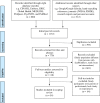Participation experiences of people with deafblindness or dual sensory loss: A scoping review of global deafblind literature
- PMID: 30212504
- PMCID: PMC6136783
- DOI: 10.1371/journal.pone.0203772
Participation experiences of people with deafblindness or dual sensory loss: A scoping review of global deafblind literature
Abstract
Background: Deafblindness, also known as dual sensory loss, is a varying combination of visual and hearing impairment in the same individual. Interest in this topic has increased recently due to evidence suggesting an increase in prevalence of this condition among older adults. Persons with deafblindness frequently experience participation barriers and social isolation. Developing an understanding of their experiences can inform the design of programs and policies to enhance participation of people with deafblindness in society.
Objective: To identify and summarize available research literature on participation experiences of people with deafblindness or dual sensory loss.
Methods: A comprehensive literature search of eight databases (CINAHL/EBSCO, Embase, ERIC, Global Health, MEDLINE, ProQuest, PsycINFO, PubMed) was performed in accordance with the Preferred Reporting Items for Systematic Reviews (PRISMA) during January 2017 and last updated in June 2017. In addition, non-peer reviewed (grey) literature was also retrieved in the form of online published reports of research projects by 16 deafblind-specific organizations across the globe. To be included, sources had to be published after 1990, had persons with deafblindness as the focal population, and focused on their participation experiences.
Results: A total 1172 sources were identified of which 54 studies were included. The findings reveal that persons with deafblindness, regardless of origin of their impairment, experience difficulty in communication, mobility, daily living functioning, and social interactions. While these experiences may vary between individuals with congenital versus acquired conditions, they generally feel socially isolated, insecure and uncertain about their future.
Conclusion: Participation experiences of persons with deafblindness are shaped by dynamic interactions between personal factors (such as onset and type of impairments) and environmental influences (such as attitude, technology, and supports). A better understanding of participation experiences may help professionals in placing emphasis on affected participation domains to design services to enhance participation of people with deafblindness.
Conflict of interest statement
The authors have declared that no competing interests exist.
Figures
Similar articles
-
Using the ICF to Identify Contextual Factors That Influence Participation of Persons With Deafblindness.Arch Phys Med Rehabil. 2019 Dec;100(12):2324-2333. doi: 10.1016/j.apmr.2019.03.010. Epub 2019 Apr 12. Arch Phys Med Rehabil. 2019. PMID: 30986411
-
Device abandonment in deafblindness: a scoping review of the intersection of functionality and usability through the International Classification of Functioning, Disability and Health lens.BMJ Open. 2021 Jan 25;11(1):e044873. doi: 10.1136/bmjopen-2020-044873. BMJ Open. 2021. PMID: 33495263 Free PMC article.
-
Use of three-dimensional printing as a rehabilitation tool for individuals with deafblindness or vision impairment: a scoping review protocol.JBI Evid Synth. 2021 Oct;19(10):2790-2800. doi: 10.11124/JBIES-20-00374. JBI Evid Synth. 2021. PMID: 34645775
-
Meaning and experiences of participation: a phenomenological study with persons with deafblindness in India.Disabil Rehabil. 2020 Sep;42(18):2580-2592. doi: 10.1080/09638288.2018.1564943. Epub 2019 Jan 27. Disabil Rehabil. 2020. PMID: 30686125
-
The International Classification of Functioning, Disability and Health (ICF) core sets for deafblindness, part II of the systematic review: linking data to the ICF categories.Eur J Phys Rehabil Med. 2024 Oct;60(5):893-902. doi: 10.23736/S1973-9087.24.07984-X. Epub 2024 Sep 5. Eur J Phys Rehabil Med. 2024. PMID: 39235255 Free PMC article.
Cited by
-
Using participatory and inclusive methodologies to explore inclusive education in Africa.Afr J Disabil. 2024 Oct 18;13:1486. doi: 10.4102/ajod.v13i0.1486. eCollection 2024. Afr J Disabil. 2024. PMID: 39507005 Free PMC article.
-
Consensus clinical management guidelines for Alström syndrome.Orphanet J Rare Dis. 2020 Sep 21;15(1):253. doi: 10.1186/s13023-020-01468-8. Orphanet J Rare Dis. 2020. PMID: 32958032 Free PMC article.
-
The development of the International Classification of Functioning, Disability and Health Core Sets for deafblindness: A study protocol.PLoS One. 2021 Dec 14;16(12):e0261413. doi: 10.1371/journal.pone.0261413. eCollection 2021. PLoS One. 2021. PMID: 34905579 Free PMC article.
-
The Effect of Dual Sensory Impairment and Multimorbidity Patterns on Functional Impairment: A Longitudinal Cohort of Middle-Aged and Older Adults in China.Front Aging Neurosci. 2022 Apr 8;14:807383. doi: 10.3389/fnagi.2022.807383. eCollection 2022. Front Aging Neurosci. 2022. PMID: 35462686 Free PMC article.
-
Experiences of rehabilitation services from the perspective of older adults with dual sensory loss - a qualitative study.Int J Qual Stud Health Well-being. 2022 Dec;17(1):2052559. doi: 10.1080/17482631.2022.2052559. Int J Qual Stud Health Well-being. 2022. PMID: 35350956 Free PMC article.
References
-
- Wittich W, Southall K, Sikora L, Watanabe DH, Gagné J-P. What’s in a name: Dual sensory impairment or deafblindness? Br J Vis Impair [Internet]. 2013. September 13;31(3):198–207. Available from: http://journals.sagepub.com/doi/10.1177/0264619613490519 - DOI
-
- Dammeyer J. Deafblindness: A review of the literature. Scand J Public Health [Internet]. Dammeyer, Jesper: Sage Publications; 2014. November 1;42(7):554–62. Available from: http://sjp.sagepub.com/cgi/doi/10.1177/1403494814544399 10.1177/1403494814544399 - DOI - DOI - PubMed
-
- Möller K. Deafblindness: a challenge for assessment—is the ICF a useful tool? Int J Audiol [Internet]. 2003;42 Suppl 1(September):S140–2. Available from: http://www.tandfonline.com/doi/full/10.3109/14992020309074635 - DOI - PubMed
-
- Danermark BD, Möller K. Deafblindness, ontological security, and social recognition. Int J Audiol [Internet]. 2008. November 7;47 Suppl 2(sup2):S119–23. Available from: http://www.tandfonline.com/doi/full/10.1080/14992020802307388 - DOI - PubMed
Publication types
MeSH terms
LinkOut - more resources
Full Text Sources
Other Literature Sources







